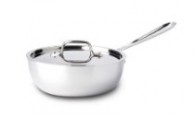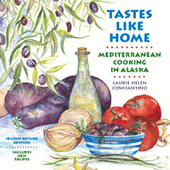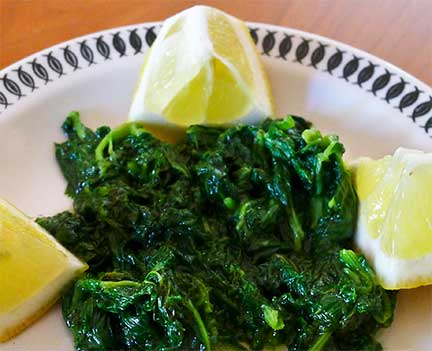
Greek Cow Parsnip Salad with Lemon Dressing. Photograph by Laurie Constantino
After reading my recent cow parsnip article and cow parsnip salad recipe, Susan asked “In Janice Schofield’s book Discovering Wild Plants, she says to peel [cow parsnip] stems. I didn’t see that step in your blog post, so maybe that’s optional?
Good question Susan. Discovering Wild Plants is the best resource for anyone wanting to forage wild foods in Alaska, so you’re wise to be asking about it. If you’re an Alaska forager or wannabe, this book is a must buy. It’s well researched, well illustrated, and quite reliable. I pull it out every year and always find new information.
About cow parsnip, Schofield says:
Cow parsnip stems can be eaten raw, or cooked; stems should always be peeled before taking internally. (Some individuals are highly allergic to the plant. See Caution, following.) Stems, stuffed with cream cheese or seafood fillings, make an attractive hors d’oeuvre. For a mail meal, fill stems with cheese or meat and bake with tomato sauce. Cow parsnip makes an excellent substitute for celery in cream soups, casseroles, and stir-fries.
Under “Caution,” Schofield discusses the dermatological effects of furanocoumarins found in cow parsnip sap and outer hairs and specifically notes the danger if “unpeeled stems are touched to the face and lips.” There’s no mention of side effects other than dermatological.
I agree raw cow parsnip stalks must be peeled to be edible. Honestly, I’m so dermatologically reactive to cow parsnip I’m afraid to eat it raw, even if it’s been scrupulously peeled.
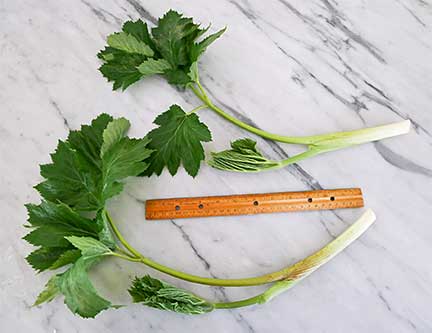
Immature Cow Parsnip Leaves & Stalks. Photograph by Laurie Constantino
On the other hand, over the last week, I’ve been on a cooked cow parsnip binge, haven’t peeled a single stalk, and have had no adverse reactions. I’ve roasted the stems, turned them into curry, and even into ice cream. Keep in mind, this is only one person’s experience. It’s important to eat only a small quantity the first time trying any wild plant to assess possible reactions.
In his books Identifying and Harvesting Edible and Medicinal Plants in Wild (and Not So Wild) Places and The Wild Vegan Cookbook, famed Central Park forager “Wildman” Steve Brill, acknowledges the need to peel raw stalks. He says,
The very young leafstalks and very young flower stalks, which taste like celery, are the best parts of this plant. You can peel them and eat them raw, simmer them in soups, or boil them in a couple changes of water, depending on how strong they taste to you. The longer you cook them, the milder they get.
Without a definitive answer from foraging experts, I turned to the scientific literature.
According to an article in the Journal of Agricultural and Food Chemistry,
“Furocoumarins represent a family of natural food constituents with phototoxic and photomutagenic properties. They are found mainly in plants belonging to the Rutaceae and Umbilliferae such as celery, carrots, and parsnips.” Cow parsnip is a member of this same family.
As with cow parsnip, furocoumarins in celery causes skin problems. For example, “Celery workers and handlers in grocery stores as well as celery field workers have been affected by abnormal skin redness and blisters.”
My interpretation of what this all means, keeping in mind I have no scientific or medical expertise whatsoever, is raw cow parsnip stalks need to be peeled, while cooked cow parsnip stalks do not. We all regularly eat furanocoumarins to no ill effect and I see no reason to single out cooked cow parsnip for special treatment.
I’m very interested in others’ analysis of this issue, and hope that others with more knowledge and experience than I will weigh in.
In the meantime, I’ve finished two new cow parsnip recipes. The first, Cow Parsnip Chips (think Kale Chips) uses only leaves and the second, Roasted Cow Parsnip Stalks, uses only stalks. Stay tuned for Cow Parsnip Ice Cream. The recipe just needs one more test, but I know already that it’s a keeper.
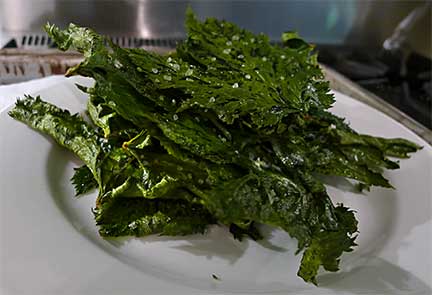
Cow Parsnip Chips. Photograph by Laurie Constantino9



